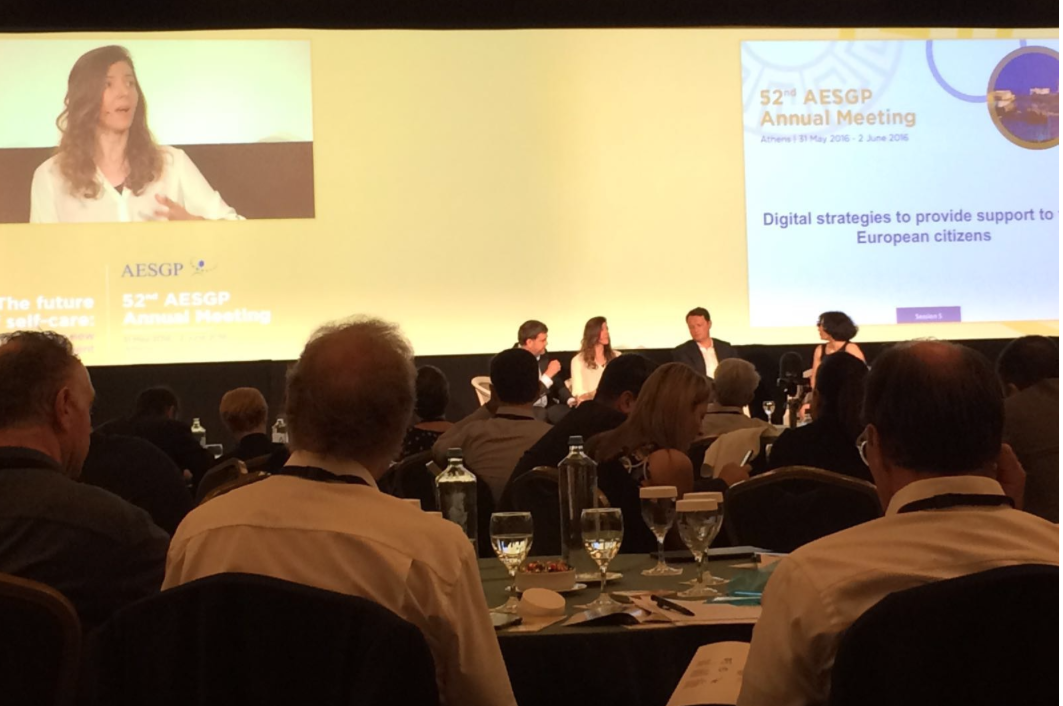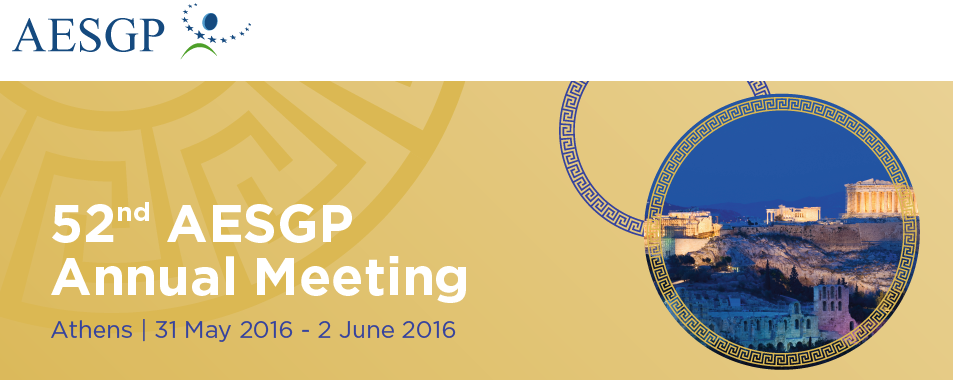This past Thursday I was honored to share my views on «Digital strategies from Spanish pharmacists to provide support to the citizens» at the 52nd AESGP Annual Meeting in Athens, Greece. Due to the great interest on the session, a transcript of the Speech and the presentation is posted here today.
Thank you for attending the Morning Session moderated by Sophia Filaktou, Business & Industry Solutions, SAP and thank you to the organization for allowing me to share it with this great panel:
– Laurent Faracci, Senior Vice President, Global Marketing and Digital Excellence, RB
– Inma Riu Torrens, Pharmacist, Director, Saludability
– Laurent Corazza, DIGILITYX
Digital strategies from Spanish pharmacists to provide support to the citizens
Let me start with some data:
- In Spain 8.7 out of 10 mobile telephones are smartphones
- Internet users between 55 y 64 are becoming digital. 27,15 millones of Spaniards access Internet regularly. 22,2 millions connect daily to the Internet (78 % live connected)*
- 61,4% of users between 55 and 64 are intensive users (they connect daily to the Internet). And it is the highest growing segment.
BUT… are spaniards ready to understand online health information?
80% of Spanish internet users search for online health information. Do they understand it?
Health literacy concerns the capacities of people to meet the complex demands of health in modern society. In spite of the growing attention for the concept among European health policymakers, researchers and practitioners, information about the status of health literacy in Europe remains scarce.
According to the European Health Literacy Survey, Europe has a 12,4 % of inadequate Health Literacy. In Spain this % is of 7%.
It is necessary to enable Spanish citizens to access online health professional information (of quality). Pharmacist can have lots to say delivering health information directly to consumers.
There are more than 21.000 retail (independent) pharmacies in Spain, some of them have decided to go online to offer direct advice to consumers and patients, in this presentation a selection of the 5 top projects will be commented.
But why pharmacist decide to go online:
- Offer advice (feeling the necessity to offer good and trustable advice online)
- Branding (enhancing user engagement)
- Open new opportunities (e-commerce, media collaborations)
Let me introduce you Que me Das Para that stands for: what can you give me for…
Lucia and Ismael are two pharmacist from Asturias who decided to videoblog health advice. Why videoblog? As you all know, Youtube is the second largest search engine.
YouTube has over a billion users — almost one-third of all people on the Internet. Growth in watch time on YouTube has accelerated and is up at least 50% year over year for three straight years.
Why online videos? Spanish is the second largest language in the world (European and South American market) and videos are easy to understand and accessible.
Quemedaspara is a local project from a region in Spain that has gained the respect from the readers and community pharmacists and has done a few cameos with several Spanish actors and local singers.
They focus on their daily commom questions asked on their counters and they have also blogged for El Mundo, one of the largest newspapers in Spain and they also do promotional videos for different pharmaceutical companies.
They focus their advice on: allergies, antihistamines, babies, cold and flu, sport, diet, pregnancy, ibuprofen, paracetamol, burns or vitamins.
You can see their VIDEO in this link.
The second case is Boticaria Garcia.
The blog boticariagarcia.com born in 2012 and has this past april been awarded as the best Healthcare blog and best Spanish blog according to the 20Minutos (newspaper).
Mother of two and from a small pharmacy in Madrid, area , she decided to give online healthcare advice after she finished her PhD. She is very involved in the Spanish mummy blogging sphere and she writes for several magazines and is a well-known speaker in the retail pharmacy.
You can see her Prezi in this link
The third case is Pharma 20, a project that was born when the wife of one of the owners of Farmacia Barios was pregnant of triplets. They realized there was a lack of information about triplets and all the information that theuy could find, was of no trusted resources. Therefore they decide to create a website to offer health advice in a video and text format.
Based in Lleida, a town from Spain, their goal is to give health advice to local pharmacy consumers and internauts who may be in need of healthcare information.
Their startegy is both on and offline. In their pharmacy they have more than 5000 emails (data base) so everytime a registered customer buys a product, he/she receives an email with a text or a video advice with the information on how to use the product. The idea is to get reinforced information of what he has just been given in the pharmacy.
Online, they have more than 4000 subscribers who receive a weekly newsletter with their weekly post.
Pharma20 gets an average of 300 health consultations a month. The most asked question is how to take medicines… this is why they have introduced videos on how to take specific medicines.
In order to engage with the customer and to create synergic actions with companies, they have a “test club” where they offer the chance of trying products for free . Those products can either be collected in their pharmacy or received by post.
They have more than 1 million reproductions on their YT chanel and more than 4000 subscribers. At the beginning they were centered in their most wide target: mums and babies, but due to their online growth, they have now started offering advice on how to use medicines (paracetamol, ibuprofen,…).
In Facebook, with more than 10K followers, they give health advice and comment on everyday news realted to health that commonly appear in magazines and newspapers. They also receive health consultations via Facebook.
Medicadoo is a pharmaceutical health advice blog. The idea is to offer health advice worldwide . Their goal is to offer quality health advice to the common questions they encounter on the counter. Promote self-care and healthy lifestyle
How do they do it?
All of them are community pharmacists based in different pharmacies in Andalucia, and they try to solve their daily questions received at work:
- What are the medicines for,
- how are they supposed to use them,
- they also review products and
- recommend healthy habits.
Always using a very understandable language without losing professionalism. They are very well-known for their infographics.
This infographics are shared amongst pharmacists and pharmacies and other health websites
They receive all sort of questions in their web:
-How to use beauty products
-I use XXx medicine that is causing me aphonia, what shall I do?
-How does the Inhaler Chamber work, how do I clean it?
-Best smoking cessation therapies
-I am a pharmacist and I have a question…
After 6 months they have achieved more than 500k visits, with a more than 300% of increase a month.. This last month they achieved more than 130k visits. 76% of their visits are from Spain and 18% come from the Latam countries.
Facebook: With more than 12K followers their infographics are widely shared
Instagram: based on beauty products they combine healthcare information with comments on new releases.
Susitravel
@susitravel. Is a pharmacist who works as a community pharmacist in Madrid and a Twitter heavy-user.
According to her, one of the tasks that community pharmacist have is is to provide accurate, valuable and updated information about any medicine and disease.
Many colleagues struggle daily against “Doctor google” and for this, they use excellent tools like blogs and videos. Thanks to them, Spanish patients (who are increasingly starting to get empowered) are getting a great pharmaceutical advice .
«Self-care is one of the basic pillars of the growth of any pharmacy. So, I decided to help from within the trenches»
What does she do?
- Some Mondays she write a situation/symtpom/frequent asked question in a notepad.
- Then she adds related products that can be offered in the pharmacy.
- She releases it on twitter with a question: «What else can you think of?
- And finally the ”pharmacy Twitter family» starts thinking about it.
On that Friday she composes a table with all contributions.
Usually over 50 pharmacists are involved, then she uploads it to her blog with names of all who have participated (recognition, gains higher virality). The table is available to be downloaded for free for any pharmacist and each table is shared via Twitter and downloaded about 1000 times.
The Key to their success
- Pharmacist offering health and independent trustable advice online
- They have created a community around their brand
- They have quickly adapted to what the consumers need, and offered them specific advice
- They are methodic and they have different strategies, most of them have a clear ROI: e-commerce, media appearances, advertising, networking…
- They use social media in order to gain virality
Food for Thoughts
A need of common European digital presence guidance would be necessary from Bodies in order to now what can and can not be said online
A Global Cerification similar to HonCode for pharmacists would be the a good tool to standarize and evaluate healthcare advice given from community pharmacists
Please, find the whole presentation in this embedded slideshare
I would like to finish this post with a big thank you and congratulations to the great team at the AESGP organization for such an excellent venue and a big thank you to ANEFP for all their support.


[…] cadenas de farmacias en Inglaterra. No me extraña que en Europa se quedaran sorprendidos de lo que los farmacéuticos españoles hacen a nivel digital. Pero sin que nos suba a la cabeza, su presupuesto en marketing es mayor que el de cualquier […]